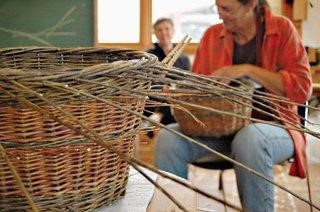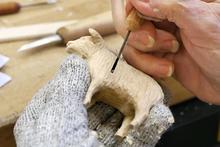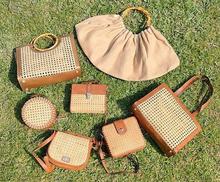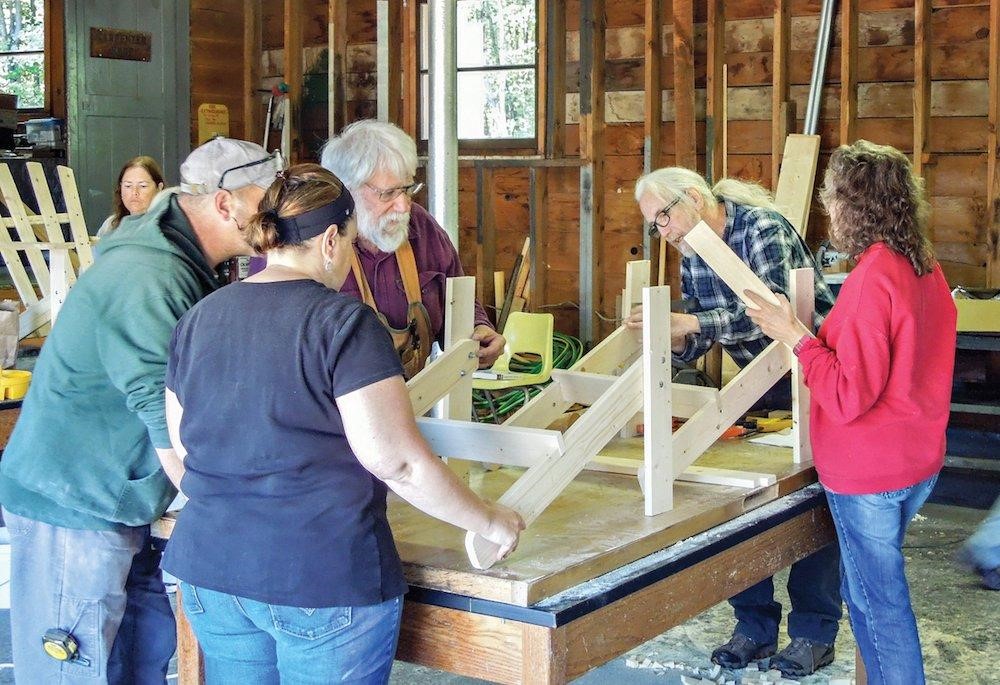What is Folk Justice? People-Centered, Home-Grown, and Restorative
by Ted Lewis
Author’s note: The content of this article was first delivered by Ted Lewis on August 19, 2021, at Harbor Park in Grand Marais at a community information gathering for Cook County MN Restorative Justice, a program of North Shore Health Care Foundation. What follows is now an amplified version of that talk. It was also first printed in the Cook County News Herald in September 2022.

In many ways, restorative justice is akin to folkways, especially to folk traditions of making things like baskets or canoes from natural resources. A lasting wisdom gets passed on from person to person. Since Grand Marais is home to the North House Folk School, one of the largest folk schools in the upper Midwest, I’d like to coin the term ‘folk justice’ and talk about how restorative justice shares most of the distinguishing features of making folk arts and crafts.
The modern movement of restorative justice stems back to the mid-1970s. Two Mennonite probation officers in Ontario got permission from a judge to allow their offenders to meet with their vandalized victims to have a facilitated conversation about the crime, apologize, and offer to make amends based on victim inputs. In the 1980s and 90s many recognized how this reparative approach to justice aligned very well with centuries-old indigenous traditions worldwide. Native cultural ways and values eventually informed some of the modern practices.
In the same way that indigenous traditions are passed on through modeling and experiential learning – again, person-to-person – folkways also carry this element. The word ‘folk’ stems from the German volk which simply means ‘the people’. The Volkswagen, for instance, was first branded as the People’s Car, albeit at the height of Nazi Germany. But the folk concept is much older in Europe. In my view, folk traditions themselves are part of any group’s indigeneity, including all Euro-white folk.

A key value for North House, as stated on its website, is for all work and teaching to be “rooted in people.” This value is central to restorative justice. In many ways, modern restorative justice emerged as a corrective to a criminal justice system that was not people-centered. By focusing more on the harm done than the law broken, restorative models have highlighted the personal and relational dimensions of crime. Serving both harming and harmed parties equally points the way to dialogue processes that place people center-stage to humanize their experiences and repair the harms.
One nice way to connect the dots between folk arts and folk justice is to think about Abraham Lincoln’s famous triad about a government “of the people, by the people, for the people.” (Actually, this line stems from 14th century Bible translator John Wycliffe, who himself started a literary folk movement.) There is a deep connection and vital continuity between 1) where folk arts come from, 2) who makes them (by), and 3) for whom they are made. People, people, and people!
I want to present several features of any folk tradition, and then make some connections to how they relate to folk justice.
1. Small-Scale and Local. A big part of folk arts is that they do not aspire toward large-scale factories or wide-spread distribution. The local scene is central as both a source of resources and a place for production and selling. Small-scale also implies a ‘hands-on’ approach to learning skills. Smaller groups have to gather in-person to watch how things are done. They learn by absorbing what they see and hear. Apprenticeships are routine. Both makers and buyers of products often get to meet each other. Folk ways represent our pre-industrial world prior to mass production.
Restorative Folk Justice also leans toward a home-grown, small-scale approach. Facilitators meet with harming and harmed people separately at the front end to hear stories and build up a credit of trust where there is a debit of trust. This is also a strength-based model where the people most involved are empowered to actively engage in hard but healing conversations; in joint dialogue, the parties themselves, with family and support people present, determine workable solutions. This sort of work necessitates a local, in-person framework.
2. Enduring and Sustainable. The reason anything passes forward over long periods of time is because it has already stood the test of time. It is durable. That’s how things last. Hence, the skills for making quality furniture from hardwoods, for example, are themselves part of what gets passed on to sustain furniture that lasts. Things that last have greater value; it’s the chipboard shelving unit that gets thrown away without any hesitation. Consider how storytelling is part of a folk tradition with enduring qualities. Stories are told and retold because they ‘work’, they reach people, and they have a predictably positive effect.
Restorative Folk Justice prizes these same values of durability and lasting effect. When harming and harmed people come together to share their stories, a higher quality of conversation begins to unfold. New and unexpected things are heard, deeper understanding and empathy is exchanged, sincere apologies are made, and at some point “Shift Happens.” People are ready to let go of the past and talk about co-existing in the future. These conversations are very memorable for both sides. This is not a justice that measures pain for pain; it is a justice that heals and then keeps on giving new life.

3. Beauty and Simplicity. It is hard to put words to a folk aesthetic, but we would all agree that there is a distinguishable look to folk arts and crafts. Even folk music is defined by a type of beauty and simplicity; it is simple because it does not rely on electronics. The quality of materials, the shapes, the patterns, etc., all matter. Over time, these things synergize because they work well. Again, with the music analogy, chord patterns and chorus melody-lifts have classic structures with their own innate strengths. This is why we take classes in the folk arts. We want to revel in the beauty and simplicity by repeating it.
Restorative Folk Justice is certainly simpler than an intensive court process where information is highly managed and communication is highly restricted. In strong contrast, a restorative conference or circle process provides a container that is both strong and simple. Ground-rules of confidentiality and respect basically allow folks to say whatever they want to say, and time is rarely limited. The beauty element has to do with what I call the Heart Zone. When people move out of their defensive Head Zone and enter a more open-hearted zone of hearing others, they usually end up being heard well. This brings about the beauty of human connection; it creates harmony where there was once discord.
4. Transmissible and Flexible. The way new people learn about folk arts is by being in the presence of one who has already mastered the tradition. It is not just what the master teaches; it also has to do with the master as a person. Musician Charlie Parr, for example, didn’t just learn picking techniques from Spider John Koerner in Minneapolis. He absorbed something more personal, even spiritual about the place of music in one’s soul. At the same time, the student who learns folk ways by practicing their craft comes to a point of mixing a learned tradition with new elements woven in. The Old is flexible enough to transform into something New that is fresh and relevant.
Restorative Folk Justice is similarly relational in the way dialogue models are passed on. Facilitation trainers present not only skills and structures that have stood the test of time; they also present themselves as persons who have presence among others. This translates into the way facilitators contagiously influence participants in restorative conference and circles. People lift up into their higher selves by what they see and hear. Meanwhile, experienced facilitators intuit their way through meetings. Every process is a combination of predictable and unpredictable elements. Facilitators therefore are responsive and flexible to make each process unfold as best as possible.

In the end, people are magnetically drawn to folk ways for the same reasons they would be drawn to folk justice. It’s the same thing when contrasting fast food with slow food. The latter has more quality; it is more soulful because real love was infused into the making and presentation of the food. People can pick up on this sort of thing. It is no different with a justice process. Court rooms tend to extract something out of you; dignifying dialogue tends to fill you up.
Over the past five years or so, the foundations for folk justice have been laid down here in Grand Marais. The Cook County MN Restorative Justice Program, with supports from the District Attorney and Sheriff Department, has provided a community-based framework for addressing crimes and school-related harms with the help of trained facilitators. But this is just a beginning. More supports are needed to strengthen and expand programming with both staff and volunteers.
Ultimately the community holds much wisdom that can help resolve local problems, harms and conflicts. Everyone has a story to share which can benefit someone else. If you have a backstory of harming or being harmed, perhaps you can be included in a meeting with a teenager who could hear your story. Maybe you have a natural gift to facilitate (French facile… ‘to make easy’) conversations between two parties. Training for new facilitators is provided when needed. At minimum, maybe you just have a story to share. Perhaps that story can be helpful for another person to hear. Sharing stories is a big part of the folk nature of restorative justice.
The craftwork of folk justice is this: holding space for hard but healing conversations about harm. This happens in the heart zone much better than the head zone. Justice is not a contest between sides where there are winners and losers; it is a connection between sides to the extent that things are made right and everyone wins. This positive contagion of winning also promises to transform entire social systems from harmful legacies of competition to beloved communities of cooperation.
Though ‘folk justice’ is a new term, it is actually as old as the hills. As with midwifery, this wisdom has been around for a long time. As the ways of justice weave with and into the grain of the universe, there is always more learning in this rich field. It becomes a way of life. And like whittling wood, you can’t just do it any way you want. Folk ways remind us that you have to work with the wood. It’s high time we start learning how to work with people as they are.